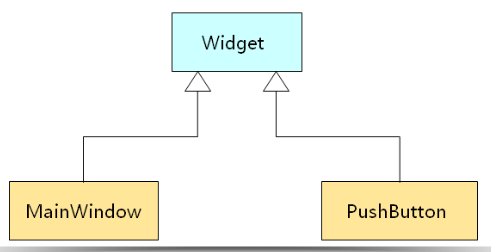一、GUI用户界面元素
(1)、GUI应用程序是由固定的窗口元素所构成

(2)、操作系统提供了创建用户界面元素所需要的函数
(3)、各自功能不同的函数依次调用,从而创建出界面元素
(4)、操作系统提供的元素函数无法直接映射到界面元素
二、面向对象的GUI应用程序设计
1、GUI应用程序的应用
(1)、GUI应用程序是为了解决非科学计算问题而诞生的
(2)、GUI应用程序适用于非专业的日常生活领域
(3)、面向过程程序设计方法学不适合GUI程序设计
(4)、面向对象程序设计方法学更适合GUI程序设计
2、用面向对象的方法看待GUI程序设计
(1)、用面向对象的方法看待GUI界面元素
(2)、所有的界面元素都可以看做实际的对象
(3)、GUI用户界面是由各不相同的对象组成的
(4)、如主窗口对象
A、菜单对象
B、按钮对象
C、文本框对象
3、GUI应用程序非常适合采用面向对象的方法学
(1)、将界面元素定义成对应的类
(2)、通过抽象和封装可以隐藏界面元素的细节
(3)、程序的创建过程就是组合不同元素对象的过程

//main.cpp


#include <windows.h> #include "Application.h" #include "MainWindow.h" #include "PushButton.h"BOOL WINAPI WinMain(HINSTANCE hInstance, HINSTANCE hPrevInstance, LPSTR lpCmdLine, int nCmdShow) {Application a(hInstance, lpCmdLine);MainWindow w(hInstance, L"Main Window");PushButton b(&w, L"My Button");w.show();return a.exec(); }
//Application.h


#pragma once#include <windows.h>class Application { public:Application(HINSTANCE hInstance, LPSTR lpCmdLine);bool exec(); };
//Application.cpp


#include "Application.h"Application::Application(HINSTANCE hInstance, LPSTR lpCmdLine) {}bool Application::exec() {MSG msg = { 0 };//进入消息循环while ( GetMessage(&msg, NULL, 0, 0)){//翻译并转换系统消息TranslateMessage(&msg);//分发消息到对应的消息处理函数DispatchMessage(&msg);}return TRUE; }
//Widget.h


#pragma once#include <windows.h>class Widget { protected:Widget* m_parent;HWND m_hwnd; public:Widget();Widget(Widget* parent);HWND hwnd();Widget* parent(); };
//Widget.cpp


#include "Widget.h"Widget::Widget() {m_parent = NULL; }Widget::Widget(Widget* parent) {m_parent = parent; }HWND Widget::hwnd() {return m_hwnd; }Widget* Widget::parent() {return m_parent; }
//MainWidow.h


#pragma once#include "Widget.h"class MainWindow : public Widget { protected:static const wchar_t STYLE_NAME[];//主窗口定义 BOOL DefineMainWindow(HINSTANCE hInstance);//主窗口创建void CreateMainWindow(HINSTANCE hInstance, const wchar_t* title);//主窗口消息处理函数static LRESULT CALLBACK WndProc(HWND hWnd, int message, WPARAM wParam, LPARAM lParam);public:MainWindow(HINSTANCE hInstance, const wchar_t* title);void show(); };
//MainWidow.cpp


#include "MainWindow.h"const wchar_t MainWindow::STYLE_NAME[] = L"MainForm";//主窗口定义 BOOL MainWindow::DefineMainWindow(HINSTANCE hInstance) {static WNDCLASS WndClass = { 0 };//系统结构类型,用于描述窗口样式 WndClass.style = 0;WndClass.cbClsExtra = 0;WndClass.cbWndExtra = 0;WndClass.hbrBackground = (HBRUSH)(COLOR_WINDOW); //定义窗口背景色WndClass.hCursor = LoadCursor(NULL, IDC_ARROW); //定义鼠标样式WndClass.hIcon = LoadIcon(NULL, IDI_APPLICATION); //定义窗口左上角图标WndClass.hInstance = hInstance; //定义窗口样式属于当前应用程序WndClass.lpfnWndProc = (WNDPROC)WndProc; //窗口消息处理函数WndClass.lpszClassName = STYLE_NAME; //窗口样式名WndClass.lpszMenuName = NULL;//将定义好的窗口样式注册到系统上return RegisterClass(&WndClass); }//主窗口创建 void MainWindow::CreateMainWindow(HINSTANCE hInstance, const wchar_t* title) {m_hwnd = CreateWindow(STYLE_NAME, //通过定义好的窗口样式创建主窗口title, //主窗口标题WS_OVERLAPPEDWINDOW,//创建后主窗口的显示风格CW_USEDEFAULT, //主窗口左上角x坐标CW_USEDEFAULT, //主窗口左上角y坐标CW_USEDEFAULT, //主窗口宽度CW_USEDEFAULT, //主窗口高度NULL, //父窗口NULL, //主窗口菜单hInstance, //主窗口属于当前应用程序 NULL); }//主窗口消息处理函数 LRESULT CALLBACK MainWindow::WndProc(HWND hWnd, int message, WPARAM wParam, LPARAM lParam) {switch (message){case WM_DESTROY:PostQuitMessage(0);break;default://调用系统提供的默认消息处理函数return DefWindowProc(hWnd, message, wParam, lParam);}return 0; }MainWindow::MainWindow(HINSTANCE hInstance, const wchar_t* title) :Widget(NULL) {DefineMainWindow(hInstance);CreateMainWindow(hInstance, title); }void MainWindow::show() {ShowWindow(m_hwnd, SW_SHOWNORMAL); //显示窗口UpdateWindow(m_hwnd); //刷新窗口 }
//PushButton.h


#pragma once#include "Widget.h"class PushButton : public Widget { public:PushButton(Widget* win, const wchar_t* text); };
//PushButton.cpp


#include "PushButton.h"PushButton::PushButton(Widget* win, const wchar_t* text) {HINSTANCE hInstance = (HINSTANCE)GetWindowLong(win->hwnd(), GWL_HINSTANCE);m_hwnd = CreateWindow(L"button", //通过系统预定义的窗口样式创建元素text, //窗口元素标题WS_CHILD | WS_VISIBLE | BS_PUSHBUTTON,//创建后窗口元素的显示风格50, //窗口元素在主窗口左上角x坐标50, //窗口元素在主窗口左上角y坐标200, //窗口元素宽度60, //窗口元素高度win->hwnd(), //父窗口(HMENU)this, //窗口元素ID值hInstance, //窗口元素属于当前应用程序 NULL); }
三、QT的本质
(1)、QT是利用面向对象方法学开发的一套GUI组件库
(2)、QT将不同操作系统的GUI细节封装于类的内部
(3)、QT提供一套跨平台的类用于开发GUI程序
(4)、QT遵循经典的GUI应用程序开发模式
四、小结
(1)、GUI程序开发更适合采用面向对象方法学
(2)、所有的界面元素都可以看做是实际的对象
(3)、GUI用户界面是由各不相同的对象组成的
(4)、QT是利用面向对象方法学开发的一套GUI组件库
(5)、QT将GUI细节封装于类的内部,具有跨平台的特性




)




)



方法)





